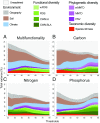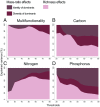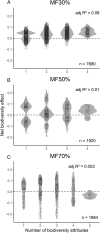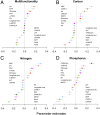Phylogenetic, functional, and taxonomic richness have both positive and negative effects on ecosystem multifunctionality
- PMID: 30948639
- PMCID: PMC6486734
- DOI: 10.1073/pnas.1815727116
Phylogenetic, functional, and taxonomic richness have both positive and negative effects on ecosystem multifunctionality
Abstract
Biodiversity encompasses multiple attributes such as the richness and abundance of species (taxonomic diversity), the presence of different evolutionary lineages (phylogenetic diversity), and the variety of growth forms and resource use strategies (functional diversity). These biodiversity attributes do not necessarily relate to each other and may have contrasting effects on ecosystem functioning. However, how they simultaneously influence the provision of multiple ecosystem functions related to carbon, nitrogen, and phosphorus cycling (multifunctionality) remains unknown. We evaluated the effects of the taxonomic, phylogenetic, and functional attributes of dominant (mass ratio effects) and subordinate (richness effect) plant species on the multifunctionality of 123 drylands from six continents. Our results highlight the importance of the phylogenetic and functional attributes of subordinate species as key drivers of multifunctionality. In addition to a higher taxonomic richness, we found that simultaneously increasing the richness of early diverging lineages and the functional redundancy between species increased multifunctionality. In contrast, the richness of most recent evolutionary lineages and the functional and phylogenetic attributes of dominant plant species (mass ratio effects) were weakly correlated with multifunctionality. However, they were important drivers of individual nutrient cycles. By identifying which biodiversity attributes contribute the most to multifunctionality, our results can guide restoration efforts aiming to maximize either multifunctionality or particular nutrient cycles, a critical step to combat dryland desertification worldwide.
Keywords: functional diversity; mass-ratio hypothesis; nutrient cycling; phylogenetic diversity; taxonomic diversity.
Conflict of interest statement
The authors declare no conflict of interest.
Figures





Comment in
-
Decoding multidimensional biodiversity.Nat Plants. 2019 May;5(5):450. doi: 10.1038/s41477-019-0431-y. Nat Plants. 2019. PMID: 31040444 No abstract available.
References
-
- Gamfeldt L, Hillebrand H, Jonsson PR. Multiple functions increase the importance of biodiversity for overall ecosystem functioning. Ecology. 2008;89:1223–1231. - PubMed
-
- Isbell F, et al. High plant diversity is needed to maintain ecosystem services. Nature. 2011;477:199–202. - PubMed
-
- Soliveres S, et al. Biodiversity at multiple trophic levels is needed for ecosystem multifunctionality. Nature. 2016;536:456–459. - PubMed
-
- Meyer ST, et al. Biodiversity-multifunctionality relationships depend on identity and number of measured functions. Nat Ecol Evol. 2018;2:44–49. - PubMed
Publication types
MeSH terms
Substances
LinkOut - more resources
Full Text Sources

